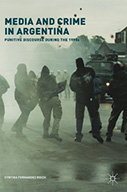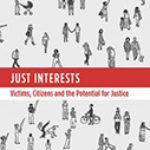Media and Crime in Argentina: Punitive Discourse During the 1990s

Author: Cynthia Fernández Roich
Publisher: London: Palgrave MacMillan, 2017. 248p.
Reviewer: Mary Fran T. Malone | October 2018
Dr. Fernández Roich poses a question of critical importance in contemporary Latin America: Why are punitive, iron fisted crime control policies so popular, even though their track record is so poor? To answer this question, Fernández Roich focuses on Argentina, and explores three issues: the role of the media, the electoral expediency of short-term policies, and a weak democratic tradition. Fernández Roich devotes most of this book to the first issue, providing a rich examination of media coverage of crime and iron fisted policies. She concentrates primarily on the 1990s, when such policies gained political saliency as “quick fix” solutions to an uptick in crime. She embeds her analysis of media discourse in the larger cultural and economic context of Argentina from the end of the dictatorship to the present. With this analysis, the author aims to understand why tough policies are consistently popular, even though they have not succeeded in reducing crime, and are typically accompanied by violations of civil liberties and human rights.
Inequality and Social Differentiation in Argentina
Before diving into her analysis of media discourse, Fernández Roich first provides an overview of important economic and social trends in Argentina. She documents the sharp increase in inequality that accompanied the sweeping privatization and neoliberal reforms of the 1990s, and notes that scholars have long recognized the role inequality plays both in exacerbating crime and politicizing crime control policy. Fernández Roich reminds the reader that highly unequal societies, with corresponding high levels of social differentiation, are more likely to resort to punitive policies and mass incarceration (page 15). When social differentiation is high, punitive policies are widely viewed as appropriate punishments to keep “them” from engaging in crimes against “us.” In the 1990s, the Argentine media portrayed “them” as pibes chorros, typecasting young, poor, urban youth as petty criminals (p.26). Fernández Roich provides many examples of the ways in which policy makers framed punitive measures as necessary to fight against these pibes chorros, and notes that citizens championed these punitive policies to punish these criminals and uphold the rights of “respectable people.” Suspected criminals “deserve to die,” and righteous citizens using force against them are not reckless vigilantes, but rather urban vindicators standing up for themselves, and ultimately the greater good of society (p. 8). The author argues that as Argentine society became more unequal, social differentiation increased, legitimizing iron fisted policies as appropriate punishments against suspected criminals to the exclusion of all other policy options (e.g., poverty reduction, increased presence of social workers, etc.). While she focuses on income inequality to explain increasing social differentiation and the subsequent appeal of these policies, it would be interesting to examine other potential causes as well. For example, internal migration also intensified during economic downturns, as people migrated from the rural provinces (especially from the North) to urban areas in search of work. Did social differentiation, a tendency to view crime as “us” v. “them,” intensify as internal migration increased?
In her discussion of the larger economic context of the late 20th and early 21st century, Fernández Roich makes a valuable distinction between the “new poor” and the “structural poor” (p.38). The former tend to hail from middle class families, and typically have expectations of a middle class lifestyle. Often members of the new poor have adequate housing and services, inheriting childhood homes or securing these basic necessities prior to the economic crises of the late 1980s and early 2000s. This class is newly poor, however, as they have difficulty securing middle class jobs and salaries that are insulated from the erosional effects of creeping inflation. The new poor may have adequate housing, but they lack a secure income to purchase consumer goods associated with middle class life, such as cars and appliances. Some newly poor also struggle with food security. The structural poor, in contrast, have not experienced this intergenerational downward mobility. Their poverty is much the same today as it was in their childhood, and they lack access to basic necessities like adequate housing. While there might not be much difference between the structural poor and new poor in terms of actual income, these two groups have access to very different resources, particularly housing.
It would seem likely that the new poor and structural poor also have very different lifestyle expectations and perspectives on crime. This is an area Fernández Roich does not explore, but would be an interesting venue for future analysis. Scholars have noted that during times of societal and economic change, people often look for a scapegoat to channel their anxieties and frustrations. In Latin America, crime has proven to be a convenient scapegoat, as people’s anxieties over socioeconomic change can manifest themselves more tangibly into fear of crime. This raises the question, are the new poor more fearful of crime? Are they more likely to endorse punitive measures? Fernández Roich’s discussion provides a starting point for future research in this area.
The Popularity of the Iron Fist
Against this social and economic backdrop, Fernández Roich examines punitive crime control policies. She clearly describes iron fisted policies, their implementation, and their impact in Argentina. Under the guise of being tough on crime, police often overlook or even refuse to follow procedures, and overuse physical power to restrain suspected criminals. For example, in 1990 a judge accused a police chief in Buenos Aires, Luis Patti, of torturing robbery suspects. When Patti defied the judge’s order for his detention, the president of Argentina and governor of Buenos Aires both spoke in his favor, while the judge’s family received death threats (p. 156). Patti remained quite popular with the public, and was regarded as a possible presidential contender in 2002. In a similar vein, during the 1999 gubernatorial campaign for Buenos Aires, Carlos Ruckauf campaigned with an iron fist, declaring “Hay que meter bala a los delincuentes” (We must shoot all thieves). Ruckauf’s campaign pledges proved popular with the public, helping him win the gubernatorial election even as his party lost nationally (p. 154). Given the popularity of punitive policies, Fernández Roich argues that police are often rewarded when they patrol with an iron fist, earning promotions, pay incentives, commendations, and choice assignments. Furthermore, the implementation of such policies creates incentives for incarceration, as effectiveness and efficiency are typically measured by arrest rates.
Following this overview of punitive policies, Fernández Roich turns to address why these policies are so popular. She focuses on media discourse, analyzing how media frame the problem of crime, portray criminals, and cover state responses to crime. She provides an in-depth, qualitative analysis of Argentine media, supporting her arguments with excellent examples of text placement, photo images, and narratives.
To analyze media discourse on crime and state responses, Fernández Roich tracks how media coverage of crime transformed in the 1990s, centering on the three most prominent newspapers in Argentina: Clarín, Página 12, and La Nación. Through extensive examples of newspaper reports (reproduced in her book), she explains that the amount of media coverage devoted to crime increased substantially throughout the 1990s. Furthermore, the media relies upon an episodic format to report crime, covering discrete events, and narrowly portraying crime as individual acts rather than as a social problem. As the police and government officials are the primary sources of information for journalists, the media tend to rely upon official statistics and statements to describe the magnitude of the problem and state responses (e.g., arrest rates).
Particularly fascinating is Fernández Roich’s analysis of media coverage of high profile cases of police abuse and misconduct. She thoroughly assesses media coverage of two cases of “trigger happy” police, noting in particular the way in which the socioeconomic background of the victims shaped media discourse. Her analysis highlights the way in which victims’ socioeconomic status is used to justify excessive use of force (p. 149). Fernández Roich also examines media coverage of police scandals, such as police involvement in a bank heist in Ramallo that turned fatal (p. 159). She notes that it is ironic that the media critique police performance and corruption, yet still endorse iron fisted policies as the only practical way to confront criminality.
Fernández Roich also attempts to draw parallels between media coverage of crime in the 1990s and the dictatorship of the 1980s. Her illustration and analysis of media portrayals of the dictatorship in 1976 are unique and fascinating, and the reprinting of news reports with annotation helps the reader visualize the analysis. She provides an excellent analysis of media discourse during the early days of the dictatorship, and the ways in which newspapers covered reports of people thrown into the sea following the confessions of some military officials in 1995 (p. 117).
While the analysis of media coverage of the dictatorship is very interesting in its own right, the connection between the dictatorship and the 1990s is not completely convincing. The author does identify a commonality between dictatorship and democracy, in that both the military and police have relied on the abusive use of force to respond to social conflicts (p 193). Fernández Roich also identifies the parallels between the dictatorship’s rhetoric to describe subversives and the democratic government’s rhetoric to describe criminals, particularly the use of biological metaphors (p. 127). However, there is not enough evidence to substantiate her argument that a weak democratic tradition can explain both the human rights abuses of the dictatorship as well as those attributed to the police under democracy. Indeed, punitive measures are often popular in countries with long democratic traditions (e.g. the United States), and unpopular in countries with legacies of dictatorship (e.g., Nicaragua). In a similar vein, attempts to link police and military abuse of power to political culture (i.e., Argentina’s alleged cultural propensity towards breaking the law) also lack sufficient empirical evidence. However, Fernández Roich’s argument concerning accountability is more convincing. She points out that the police and military personnel responsible for human rights abuses under dictatorship were rarely held accountable, and remained in their positions during the transition to democracy. As these police and military officials were never held accountable for human rights abuses during the dictatorship, they continue to use excessive force under democracy, viewing abuse as an acceptable way to target first subversives and then criminals. Of course, this raises questions as to how other countries, like Chile, were able to reduce police misconduct and abuse following the transition to democracy. Still, Fernández Roich’s discussion of the media framing of the dictatorship is very interesting and timely, particularly given the global rise of authoritarian leaders in contemporary politics, and the ways in which these authoritarians manipulate news coverage to their advantage.
Writing Style and Overall Assessment
This book is very accessible. The author writes for a general audience, but with interesting media content analysis for specialists. She aims to tie together disparate literatures, including those pertaining to media, sociology, inequality, public policy, and democratic transitions. In covering so much ground, however, some discussion of the literature remains superficial, particularly the discussions of Argentine political culture, the causes of crime, and neoliberalism. Given the many disparate literatures Fernández Roich aims to link together, she struggles a bit to organize this wide breadth of literature well. One of the major strengths of this book is its reliance on Argentine sources, as both the media analysis and theoretical arguments prominently feature Argentine journalists and academics.
While the book focuses on the 1990s, its subject is incredibly timely. The current government of Mauricio Macri has faced sharp criticism for its reliance on police force to quell disturbances related to economic deprivation, and Fernández Roich’s cautions against the criminalization of poverty and social exclusion are as relevant today as they were in the 1990s.
Mary Fran T. Malone, Associate Professor and Chair, Department of Political Science, University of New Hampshire


